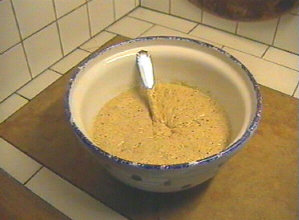Pre-ferment facts for kids
A ferment (also called a bread starter or mother dough) is a special mix used to help bread rise and taste delicious. It's a key part of making bread using "indirect" methods. This means you prepare the ferment first, and then add it to your main bread dough.
Using a ferment and letting the dough rest longer has many good things about it. It gives yeast, enzymes, and good bacteria (especially in sourdough) more time to work on the flour. This makes the baked bread stay fresh longer and gives it a richer, more complex flavor. While many big bakeries use quick yeast additions, many skilled bakers still use ferments for amazing bread.
Contents
Types of Bread Starters
There are two main kinds of bread starters:
- Sponges: These are made with regular baker's yeast.
- Sourdough starters: These use "wild" yeasts and special bacteria found naturally.
Here are some common types of pre-ferments used in baking:
Biga and Poolish
Biga and poolish are names from Italian and French baking. They are types of sponges made with baker's yeast.
- A poolish is a wet starter, usually made with equal parts flour and water. It helps make the dough stretchy.
- A "normal" biga is usually drier. Drier bigas can last longer at their best than wetter sponges.
Sourdough Starter
A sourdough starter is probably the oldest type of ferment. It relies on tiny living things found in grain and the air around us. These starters have a mix of wild yeasts and bacteria, like lactobacillus. They work together in a special partnership. Bakers often keep these starters alive for a very long time. For example, Boudin Bakery in San Francisco has used the same sourdough starter for over 150 years! In French baking, a similar term is levain.
Mother Dough
The term mother dough often refers to a sourdough starter. In this case, a "starter" is a piece of the mother dough. However, mother dough can also mean a first-time yeast sponge. So, it's important to know the ingredients and how long it ferments to tell if it's a yeast or sourdough method. In French baking, a similar term is Chef.
Old Dough (Pâte Fermentée)
Old dough (or pâte fermentée) is simply a piece of dough saved from a previous batch. You can make it with yeast or sourdough cultures. To keep it alive, you add more flour and water to feed the tiny organisms. Unlike other pre-ferments, old dough usually contains salt. If old dough rests for another 10 hours, the French call it Levain de Chef.
History of Poolish
The story often told about the term poolish is that Polish bakers first used it around 1840. This is why it got its name. It's said the method came to France in the early 1920s. However, "Poolish" is an old English way of saying "Polish." The word seems to be used mostly in France, where "polonais" means "Polish." Some old writings from the 1800s use "pouliche," which is a French word for a young female horse. No one knows for sure where the term "poolish" truly came from.
How to Use a Ferment
A ferment is usually easy to make. It's a simple mix of wheat flour, water, and a leavening agent, usually yeast. Some bakers add salt or sugar, but usually, these are left out. Salt and sugar can slow down yeast growth. They are typically added later to the final bread dough. The exact amounts depend on the recipe for the ferment and the final dough.
In some countries, especially in Eastern Europe and Nordic regions, bakers also use rye flour to make a starter. Traditional Finnish rye starter uses only rye flour and water, with no sugar or yeast. Sometimes, yogurt is added to help the starter rise faster.
A common mix is one part flour to one part water, which makes a runny ferment. You can also use stiffer doughs, like two parts flour to one part water. After mixing, you let it ferment for a while. Then, you add it to your main dough. It can replace or add to the yeast you would normally use.
Bakers sometimes ferment the mixture in a warm place. A controlled environment with specific humidity and temperature can also be used.
- Cooler temperatures slow down growth and make the process take longer.
- Slightly warmer temperatures speed up growth.
- If it's too warm, growth slows down. Very high temperatures will kill the yeast. Yeast cells die between 50 and 60 degrees Celsius (122 and 140 degrees Fahrenheit).
- If a sourdough ferment gets too cold (below 10 degrees Celsius or 50 degrees Fahrenheit), it can change the culture. This can make the baked bread lose some of its special flavor.
To give the ferment room to rise, mix the ingredients in a container that is at least four or five times bigger than the mix itself. Yeast ferments usually take 2 to 16 hours to be ready. This depends on the dough's temperature and how much yeast is added. Sourdough starters made from scratch take at least several days and depend on many things.
To make a sourdough starter from scratch, you only need flour, water, and time. You keep this starter alive by "feeding" it daily with fresh flour and water, or new dough. It ferments at room temperature until it's ready. Then, you add it to your final dough. When keeping a starter at the same weight, it's good to throw away 60% or more of the starter. Then, replace that discarded part with new dough. If you need more starter, just add more new dough.
fr:Levain
See also
 In Spanish: Prefermento para niños
In Spanish: Prefermento para niños


